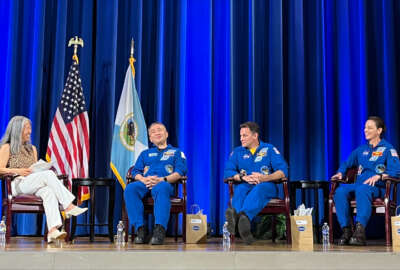
NASA’s DEIA efforts could use a boost
I spoke with Tekla Colon, Director-Mission Support Audits in NASA's IG office to discuss the agency's DEIA efforts.
NASA may have been voted the best place to work for the last 11 years, it may still have some work to do in diversifying its workforce. According to a recent report from the agency’s inspector general, it’s made little progress in increasing the representation of women and minorities in its civilian workforce or leadership ranks. To discuss some of the IG’s findings and what NASA’s doing to fix it, I spoke with Tekla Colon, director-Mission Support Audits in the IG office.
Interview Transcript:
Tekla Colon So the audit was what we call self-initiated. Meaning it was an audit that our office, as an OIG had planned to conduct through our annual audit planning process. Given that diversity, equity, inclusion and accessibility initiatives have really been a part of the agency’s recruitment and retention efforts over the last decade. And because of its mission, NASA’s relies heavily on a scientific and technical workforce to perform its critical space exploration and scientific research functions. We know that this federal scientific and technical workforce has struggled with diversity in the past. And so we determine, based on those factors, that it was the right time for us to conduct this audit. The objective of the audit was to evaluate, the agency’s efforts to increase diversity in its workforce. The work the audit team did included assessing efforts to advance diversity, equity, inclusion and accessibility, determining how the agency was updating policies and procedures to further diversity efforts, and then evaluating whether the agency was collecting sufficient and appropriate data to monitor its progress.
Eric White All right. And so let’s get into that work. What did that involve? I imagine a lot of interviews and probably a lot of data that you had to oversee. But how big of an undertaking was this?
Tekla Colon So you are exactly right. This was a big undertaking, as I think is true with with most audits conducted at the agency level. But let me try to kind of set the stage here for you. So we did look at three items when conducting this audit. The first was really focusing on the agency’s demographic data. And the approach we took was to analyze ten years worth of civil servant demographic data. So we looked at 2012 through 2021, across the agency level, at the individual center level. And then we dug a little bit deeper looking at the senior level demographic data. And in addition to that, we also looked at veteran hiring data. Over that same ten year period. So we interviewed and talked to multiple officials across the agency from the highest levels of leadership to recruiting and human resource managers at the individual centers and also folks from employee resource groups. And then lastly, we also looked at both federal and NASA criteria policies, procedures and the agency’s diversity, equity, inclusion and accessibility strategic plan to really gain an understanding of the agency’s efforts.
Eric White So it was more a programmatic view, rather than going from center to center or worksite to work side sort of deal.
Tekla Colon Correct. We looked at it in a couple of different ways. So again, the data at the agency wide level, kind of across the workforce, we drove a little bit deeper looking at individual centers, and then we dove a little bit even further deeper into looking at the senior level employees, which we kind of defined as the GSA 14,15 and senior executive service level.
Eric White Gotcha. Ok. And so let’s get into the meat of this. What is some of the major highlights of the results that you all found? I don’t mean for you to have to go line by line or anything like that, but what was the overall sense that you all took away from this report?
Tekla Colon Sure. So the report does outline two major findings. The first is really related to the little progress the agency has made in increasing its representation. And then the second finding was focused on the lack of timely and reliable data. So let me get into the first a little bit here. Our audit found that NASA has made little progress in increasing representation of both women and minority groups in its civilian workforce and its leadership ranks. So we found this to be true at both the agency level, where demographics have remained consistent with only minor increases, sometimes by just 1 to 2% for certain groups. We also found this to be true at the center level, where only two centers have increased black or African-American representation. Other centers have small increases in Hispanic and Asian American and female representation. So demographics for minority groups at the senior level also remain consistently low when compared to their white employee counterparts. And when considering gender representation had remained consistently male. So lastly, in terms of veterans, we found the proportion of veterans hired at NASA’s workforce has declined dramatically from 20% in 2015 to just 13% in 2021.
Tekla Colon So in our first finding, we also attribute this lack of progress in increasing representation to multiple factors. Really, first and foremost, the agency’s siloed approach. So responsible offices have been focused on meeting federal workforce requirements, instead of taking a more proactive approach to gathering the necessary data and identifying barriers to employment and promotion. And prior to 2021, NASA really wasn’t holding its leaders or supervisors accountable for advancing DEIA efforts. And the agency experienced some gaps in its professional development and training opportunities, including programs designed to prepare employees for more senior roles. And then lastly, we found that the agency really didn’t have reliable applicant data to help inform its decision making. Because the hiring process was primarily carried out at each NASA’s center, there was really no standardization on how this hiring and demographic data was collected or analyzed. So that’s really kind of the meat of it for our first finding.
Eric White Yeah, it was interesting reading the reports. NASA has, there are so many stories about barriers being broken because of NASA’s work. And I’m thinking of the desegregation efforts in Huntsville, Alabama, and things like that. But on the surface, it all look good. But from what you’re saying, that the data didn’t really back up, that there is much of an effort or hasn’t been much of an effort until recently in the DEIA fields.
Tekla Colon So I think over the past decade, the agency has taken efforts, but I think more recently it’s been a more focused approach, and they’re really committed to their efforts. They’ve agreed to the recommendations that we made in our report, and are looking to make planned actions kind of into the future.
Eric White Yeah, and that’s a perfect segue way in my next question, which is once you relayed this information to them, are there any sort of improvements that are coming down the pipeline? Or is things moving in the direction that the leadership wants to have it move when it comes to diversifying their workforce?
Tekla Colon So, yeah, great question. And I think the agency, like I said, is really committed to this effort and has made improvements. Our report identified seven recommendations and those recommendations were really focused on improving things like training for supervisors and hiring managers, establishing an agency wide mentoring program for the agency to really start conducting barrier analysis to identify those obstacles that prevent women and minority groups from reaching those senior leadership roles and really taking a more data driven approach to decision making. And again, the agency has agreed with our recommendation and has planned actions that they’re working to implement.
Eric White Did they mention anything in interviews that you had with senior officials? NASA’s work is so unique, the trough is already small enough with the people that they can recruit to come work for their agency. Did they mention anything about how difficult it is in the STEM field to diversify companies? And multiple agencies are having trouble in that field in making sure that they have a diverse workforce. Was there any mention of that in your interviews with senior officials?
Tekla Colon So that did come up, Eric. Historically, we know that the federal and scientific workforce has really struggled with diversity, understanding that NASA really relies on that workforce to perform its functions. We did get into that a little bit. But again, the agency has really made a commitment to moving the needle, as we say, and increasing diversity. And so they have a lot of actions in place that they’re working towards. In addition to that, as kind of a follow on to this audit. We are doing an additional audit now looking at NASA’s STEM engagement efforts. So we’re going to dive a little bit further into STEM and the STEM workforce there.
Eric White Understood, we’ll certainly have to check back with you on that one. And looking at diversity as a whole, as an issue within the scientific community and having workers from multiple backgrounds can help get different ideas in there. That’s well known. But what was the sense that you got in speaking with senior leaders about how important they value DEIA for ensuring NASA is successful in their missions?
Tekla Colon So here’s here’s kind of our take away, and I think we lay this out in our report. Even NASA, the agency that has been named the best place to work in the federal government for over 11 years and counting, really continues to struggle with increasing the representation of women and minorities in its workforce. Now, we know that the agency success relies on attracting and retaining that highly skilled and diverse workforce. It’s important for NASA and the entire federal workforce to reflect the best of us, as well of all of us. So the findings and recommendations that we made in our report are there to help NASA turn its longstanding commitment to diversity really into meaningful progress. And we understand that the agency is very committed to its efforts.
Eric White And what is its long-term goal? I imagine that they’re not going to be just looking at percentages every year trying to make sure that they have equal parts from everywhere. Or maybe they are, But what is it that they are trying to achieve? Is it just a numbers game to them or are they just trying to ensure that it’s more of a sense that employees feel that they have representation there, both in their counterpart work fields and in senior leadership?
Tekla Colon So I think it’s the latter. I think it’s more of the sense that the agency employees do feel that they’re included and that there is a diverse workforce kind of across across the agency. The agency has taken steps in its initiative to really focus on this area and to make improvements. The report kind of outlines the updates the agency has made in its DEIA strategic plan. They developed a governance structure, which elevated responsibility for DEIA efforts to the highest levels of leadership. They made updates to their strategic plan, really focusing on the data and having availability of the data, and increasing the transparency of the data to their hiring managers and to their supervisors. And then I think the last important thing to point out that the agency is doing, and maybe this may be one of the more important things, is really starting to conduct those in-depth barrier analysis reviews that look at workforce demographic data at all stages of the hiring process. From recruitment to selection to promotion to retention, to really identify those barriers to equal employment opportunity to move that needle, so to speak.
Copyright © 2025 Federal News Network. All rights reserved. This website is not intended for users located within the European Economic Area.
Eric White is news anchor and Federal Drive producer at Federal News Network.
Follow @FEDERALNEWSCAST
Related Stories





